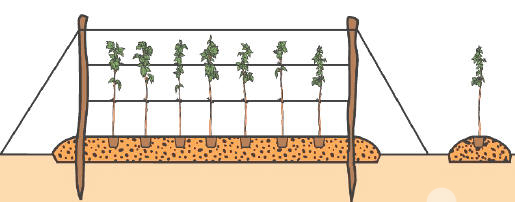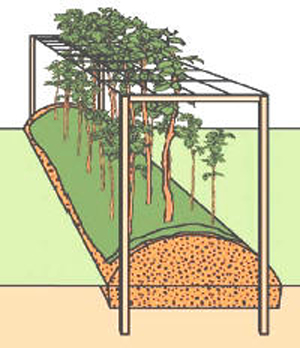Raspberry plants
Raspberry plants
Planting raspberry plants and their care
Raspberry plants (Rubus idaeus) are the most commonly planted fruit shrubs in the fruit garden besides strawberry plants. This is certainly due to the good taste of the raspberry and the easy cultivation of raspberry plants. Originating from the rose family, these plants have therefore won a permanent place in the fruit garden.
Location and planting of raspberry plants
The ideal location for raspberry plants is a wind-protected, sunny spot in the garden. To avoid root diseases, the soil should be loose and humus-rich and not too wet.
For most varieties of raspberry plants, the ideal planting time for bare root plants is from September to April, for potted plants the planting time is all year round, with strong attention to watering in summer.
Before planting raspberry plants, put the roots or pot ball in a bucket of water for 5-10 minutes.
Mixing compost or potting soil through the planting hole promotes root growth and the moisture and nutrient holding capacity of the soil. Add 1 part compost or potting soil to 2 parts soil and mix. Do not plant the plants more than 5 cm deeper than they were at the nursery.
The ideal planting distance for bare-root plants is 30-35 cm. And for potted plants 40-50 cm. If you plant several rows, the distance is 1.25 m to 1.50 m. The planting distance is important because air must be able to flow through so that the plants dry up faster after rain and fungi have less of a chance. It is also important not to overrun the soil near the raspberry plants, as they will get root diseases faster.
To support the tendrils that bear fruit, it is a good idea to stretch a few wires so they don't hang on with rain and wind. It is best to place the wires at a height of 50 cm, 100 cm and 150 cm (see photo).

Later you can pick the berries more easily
With autumn raspberries, you can also work by plane (see photo).

Care of raspberry plants
Raspberry plants are shallow-rooting plants that should be mulched regularly ( with peat in case of calcareous soils and potting soil or compost in normal to acidic soils). This prevents weed growth and drying out of the soil.
Note: It is also not good to hoe the soil, as the roots are high in the ground you would damage them.
On sandy soil, it is good to fertilise with magnesium-containing lime fertiliser in autumn.
Harvesting and pruning raspberry plants
There are 2 types of raspberry plants, summer raspberry and autumn raspberry
Summer raspberry gives raspberries already in early summer, they get these raspberries on the branches that grew the year before, you always have 2 types of branches in summer raspberry. The new 1-year-old and the fruit-bearing 2-year-old branches. You cut off the 2-year-old branches near the ground after harvesting. You then tie the new branches back to the wires no more than 5 branches per metre.
Autumn raspberries bear fruit on the new shoots that emerge from the ground, so they also bear fruit later: in late summer. In winter, prune off all branches near the ground.
